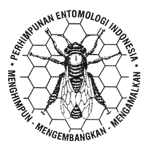The effect of mixed cultivars plantings on pest abundance and grain yields in rice
DOI:
https://doi.org/10.5994/jei.15.2.101Keywords:
brown plant-hoppers, cultivars mixture, rice, row mix, seed mix, stems borersAbstract
A field study was carried out to assess the effects of mixed cultivar plantings on grain yields and on the abundance of pests in rice. Increasing plantation species diversity through cultivar mixtures is often claimed to decrease pest problems while stabilizing or even increasing yield, but the effects on pest abundance of planting rice cultivar mixtures in Indonesia have not been extensively studied. We tested for changes in pest abundance in experimental plots planted with five genetically distinct rice cultivars, combined in two different mixture arrangements (seed mix and row mix). These mixes were cultivated in lowland paddy areas, in replicated randomized block designs, during two growing seasons. Pest abundance was measured weekly in all plots, and rice yields were measured at harvest time. The results showed that the average abundance of pests was reduced in plots planted with cultivar mixes, compared to those planted with monocrops comprised of each of the component cultivars. Plots planted with the seed mix showed consistently reduced brown plant-hopper (Nilaparvata lugens (Stí¥l)) abundance compared to monocrops in each growing season, with a relative reduction in pest abundance of 29.83% at the end of season 1 and 6.61% at the end of season 2, respectively. Plots planted with the row mix consistently showed decreased stem borer abundance compared to monocrops in each growing season, with a relative reduction in pest abundance of 100% at the end of season 1 and 1.4% at the end of season 2, respectively. In terms of yield, plant height proved to be a consistent yield component character, correlating positively with plant yield for both seed mix and row mix in both growing seasons. Our results showed higher average yields –and plant heights--for the mixed genotype plots compared to pure genotype stands in 2013. We found a greater relative increase in the yield of seed mix plots than row mix, measuring 7.26% and 4.63%, respectively in 2013. Among the two types of mixtures, seed mix showed higher overall grain yield. Our findings suggest that rice farmers can both increase yield and decrease pest abundance by planting cultivar mixes.
Downloads
Downloads
Published
How to Cite
Issue
Section
License
Authors who publish with this journal agree to the following terms:
- Authors retain copyright and grant the journal right of first publication with the work simultaneously licensed under a Creative Commons Attribution 4.0 International License that allows others to share the work with an acknowledgement of the work's authorship and initial publication in this journal.
- Authors are able to enter into separate, additional contractual arrangements for the non-exclusive distribution of the journal's published version of the work (e.g., post it to an institutional repository or publish it in a book), with an acknowledgement of its initial publication in this journal.
- Authors are permitted and encouraged to post their work online (e.g., in institutional repositories or on their website) prior to and during the submission process, as it can lead to productive exchanges, as well as earlier and greater citation of published work (See The Effect of Open Access).








